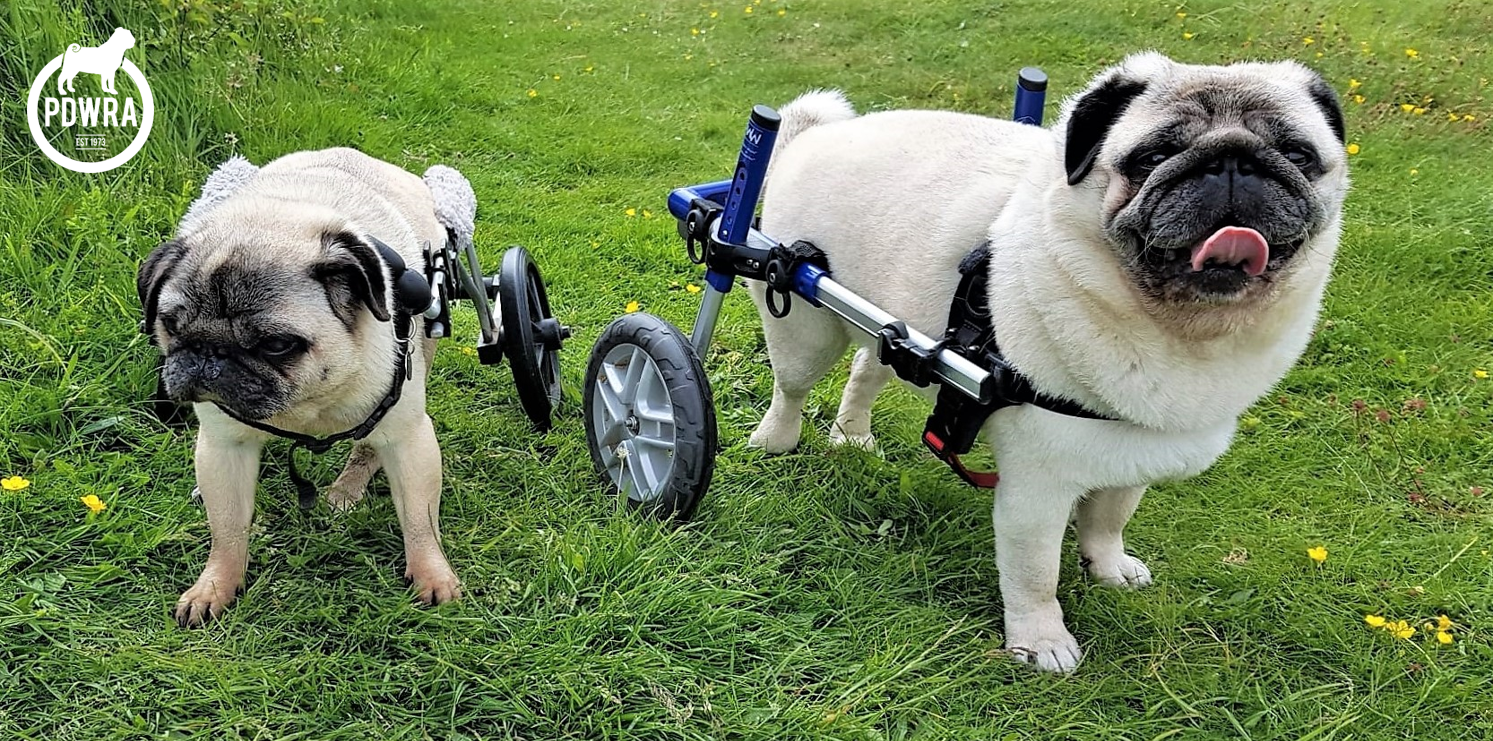Article by Dr W Malcolm McKee
PDWRA Vet Advisor

Spinal conditions in Pugs.
Conditions affecting the spine are not uncommon in Pugs, unfortunately. This is because Pugs have been bred to have flat faces (brachycephalic) and linked with this is abnormal development of their spines and early degeneration of their discs.
The first sign that your Pug may have a spinal condition could be pain (such as reluctance to jump or yelping), however, more commonly weakness (referred to paresis) or wobbliness (referred to as ataxia) of the legs is noticed. Weakness may present as scuffing of the nails and wobbliness as loss of coordination of the legs. Problems affecting the neck will cause the front and back legs to be affected and conditions affecting the thoracic and lumbar (back) areas will cause just the back legs to be weak or wobbly. Severe cases may be urinary or faecally incontinent and affected Pugs may loss the ability to walk. Signs generally come on gradually and may progress slowly over many months or even years.
A good neurological examination by your vet should enable the location and severity of the spinal condition to be determined.
The most common spinal conditions in Pugs include hemivertebrae (HV), “slipped” disc, arachnoid cyst, syringomyelia, or a combination of these conditions (Pug myelopathy). Fractures, inflammatory problems and tumours are less common.
Hemivertebrae is due to abnormal development of the vertebrae (the bones of the spine). The deformed vertebrae cause compression of the delicate spinal cord and is often severe by the time the condition is diagnosed. The discs, which are positioned between the vertebrae, often degenerate in Pugs early in life, and become hard instead of jelly-like. They are then prone to bulging (“slipping”) and compressing the spinal cord. An arachnid cyst is a build up of fluid on the outside of the spinal cord and syringomyelia is a build up of fluid inside the spinal cord. Both of these conditions may cause compress the spinal cord.
Radiographs (X-rays) may be obtained to help diagnose the spinal problem, however, they are of very limited value as the spinal cord is not visible and thus it is not possible to assess if it is compressed.
An MRI scan is the best way to investigate a Pug with a suspected spinal condition and generally the scan will reveal the cause of the weakness/wobbliness or pain. Occasionally it is necessary to perform other tests, such as analysing a sample of the fluid around the spinal cord (known as CSF).
Once a diagnosis is reached treatment options can be considered – conservative management and surgery being the two possibilities. Unfortunately, the majority of spinal conditions that Pugs develop are very challenging to treat by surgery. This is partly due to the complexity of the underlying problem, such as vertebral deformity, but also because of the chronicity (duration), severity, and irreversible nature of the spinal cord injury. Indeed it is not uncommon for Pugs to be worse, at least temporarily, after spinal surgery.
With the outlook following surgery not being good it raises the question of the value of performing an MRI scan in these cases, especially when there are financial restrictions – MRI scans and complex spinal surgery are expensive and the majority of Pugs do not benefit from one or both being performed.
Conservative management of Pugs with weak/wobbly legs involves (1) ensuring they aren’t overweight (put him/her on a strict diet if necessary) (2) restricting exercise (small amounts often with avoidance of jumping and climbing) (3) exercising on the likes of soft grass rather than roads (4) protecting the nails of the paws with boots to stop them dragging and bleeding (5) supporting the back legs with a belly band.
Some Pugs that progress to the point of being unable to walk on their back legs may benefit from a cart with wheels – candidates need to be considered carefully, as these carts aren’t for every Pug. Often these dogs are also incontinent and urinary incontinence, in particular, can be difficult to manage, especially in male dogs. Quality of life needs to be carefully monitored and euthanasia considered where appropriate – under veterinary guidance.

Malcolm with his grumble, before the loss of Lily (February ’23) and Missy (May ’23).
Dr W Malcolm McKee BVMS DSAO MRCVS
PDWRA Vet Advisor

